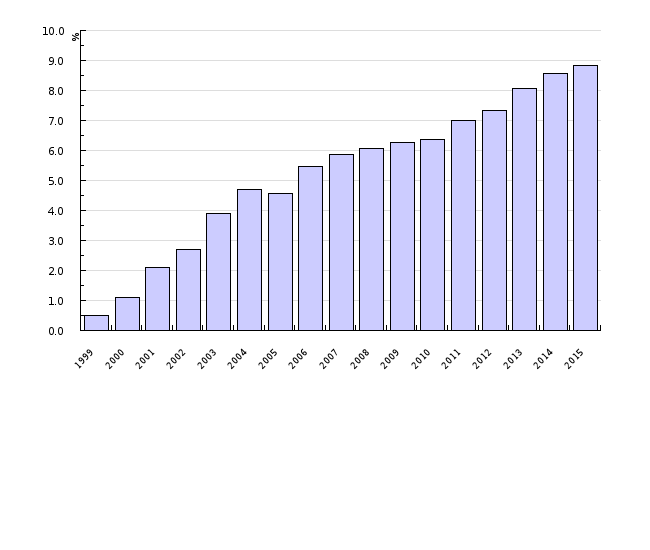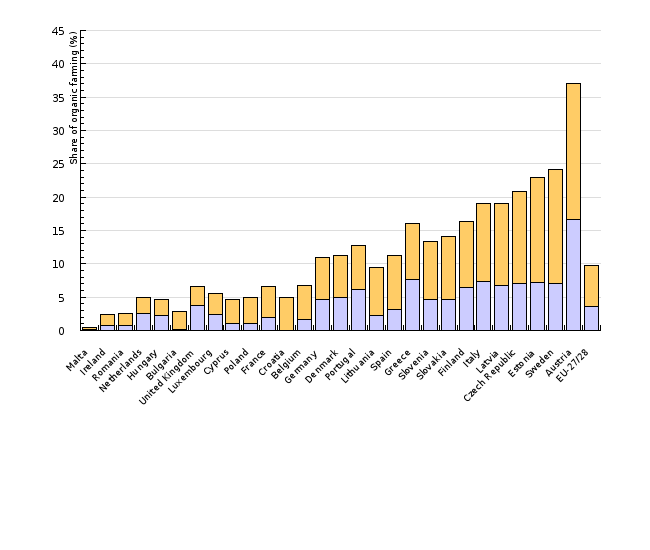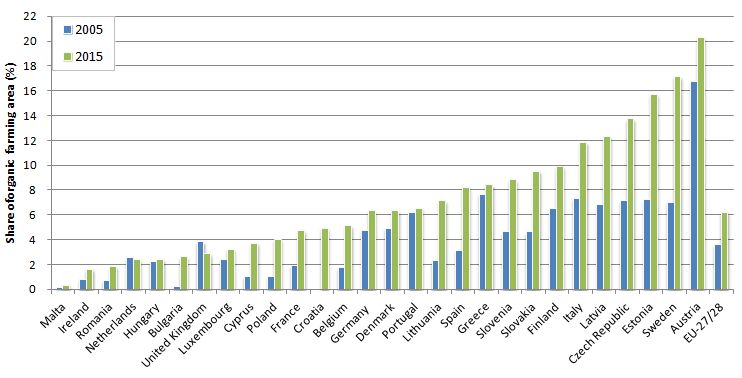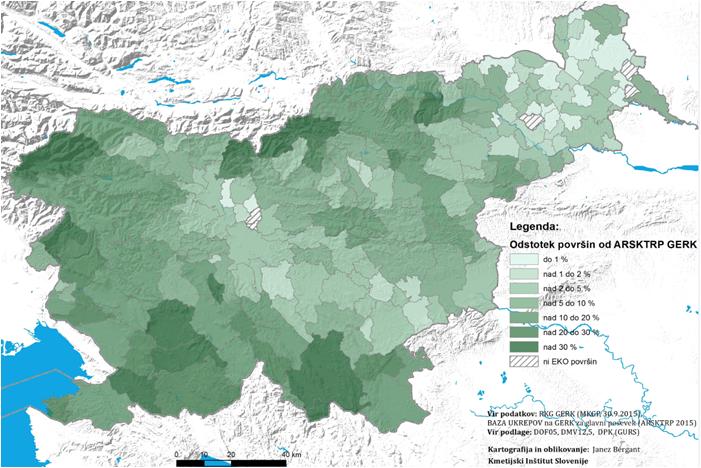[KM08] Areas of land with organic farming

Key message

The response of agricultural holdings to agricultural policy supporting the spread of organic farming has been growing from year to year. In the period 1999–2015, the area intended for organic farming increased from 2,400 to 42,188 ha, or from 0.5 to 8.8% of total utilised agricultural area. The structure of agricultural land with organic farming is still strongly dominated by grassland (82% in 2015), which shows that the decision to undergo the transition to this type of production was primarily made by animal holdings.
Definition
This indicator shows the surface area of land included in organic farming and its share in the total utilised agricultural area in Slovenia. It covers all areas included in the control of organic farming, i.e. those where organic farming has already been carried out, and those in the midst of converting to organic farming. The indicator does not provide direct information on the environmental efficiency of the measure, but points to the response of agricultural holdings to the agricultural policy supporting such production.
Charts
Ministry of Agriculture, Forestry and Food of the Republic of Slovenia, (1999-2003); Statistical Office of the Republic of Slovenia, 2016.
| 1999 | 2000 | 2001 | 2002 | 2003 | 2004 | 2005 | 2006 | 2007 | 2008 | ||
|---|---|---|---|---|---|---|---|---|---|---|---|
| Organic farming area, total | ha | 2400 | 5446 | 10828 | 13828 | 20018 | 23018.9 | 23169.1 | 26830.7 | 29322 | 29836.4 |
| Permanent grassland | ha | - | - | 10000 | 12800 | 18500 | 20908 | 21669.8 | 24458.3 | 25796.5 | 26309 |
| Arable land | ha | 721 | 908 | 1368 | 1721.7 | 1066 | 1683.9 | 2651.9 | 2608.2 | ||
| Of which vegetables and strawberries | ha | - | - | 41 | 58 | 68 | 81.8 | 141.6 | 96.5 | 107.8 | 101.2 |
| Permanent crops | ha | - | - | 107 | 120 | 150 | 389.2 | 433.4 | 688.6 | 873.6 | 919.2 |
| of which Orchards | ha | - | - | 55 | 65 | 100 | 335.6 | 359.6 | 536.2 | 668.6 | 712.3 |
| Vineyards | ha | - | - | 52 | 55 | 50 | 49.1 | 67.2 | 125 | 184 | 190.7 |
| Olive growes | ha | - | - | - | - | - | 4.5 | 6.6 | 27.4 | 21 | 16.2 |
| Hardy nursery stocks (including vine stocks) | ha | - | - | - | - | - | - | - | - | - | - |
| Utilised agricultural area (UAA), total | ha | 498591 | 508960 | 509624 | 505462 | 509709 | 490520 | 508759 | 490318 | 498466 | 492424 |
| Share of organic farming area in total UAA | % | 0.5 | 1.1 | 2.1 | 2.7 | 3.9 | 4.7 | 4.6 | 5.5 | 5.9 | 6.1 |
| 2009 | 2010 | 2011 | 2012 | 2013 | 2014 | 2015 | |||||
| Organic farming area, total | ha | 29388.4 | 30688.5 | 32148.7 | 35100.7 | 38664.5 | 41237.2 | 42188.5 | |||
| Permanent grassland | ha | 25432.4 | 26189.7 | 27531.1 | 29814.1 | 32527.1 | 34595.8 | 34653.3 | |||
| Arable land | ha | 2922.5 | 3329.7 | 3383.7 | 3787.2 | 4383.5 | 4731.7 | 5359.1 | |||
| Of which vegetables and strawberries | ha | 124.2 | 122.4 | 151.1 | 183.6 | 232.6 | 214.4 | 281 | |||
| Permanent crops | ha | 1033.5 | 1169.1 | 1234 | 1499.3 | 1754 | 1909.8 | 2176.1 | |||
| of which Orchards | ha | 780.3 | 793.1 | 855.1 | 988.4 | 1144.3 | 1260.1 | 1466.1 | |||
| Vineyards | ha | 203.3 | 296.9 | 287.2 | 324.1 | 401.3 | 421.8 | 495.2 | |||
| Olive growes | ha | 50 | 76.6 | 91.6 | 184.5 | 208.3 | 226.2 | 214.1 | |||
| Hardy nursery stocks (including vine stocks) | ha | - | 2.4 | - | 2.3 | - | 1.7 | 0.8 | |||
| Utilised agricultural area (UAA), total | ha | 468496 | 482653 | 458195 | 479653 | 478888 | 482218.4 | 476861 | |||
| Share of organic farming area in total UAA | % | 6.3 | 6.4 | 7 | 7.3 | 8.1 | 8.6 | 8.8 |
Ministry of Agriculture, Forestry and Food of the Republic of Slovenia, (2001-2003); Statistical Office of the Republic of Slovenia, 2016.
| Malta | Ireland | Romania | Netherlands | Hungary | Bulgaria | United Kingdom | Luxembourg | Cyprus | Poland | ||
|---|---|---|---|---|---|---|---|---|---|---|---|
| 2005 | % | 0.1 | 0.8 | 0.7 | 2.5 | 2.2 | 0.2 | 3.8 | 2.4 | 1 | 1 |
| 2015 | % | 0.3 | 1.6 | 1.8 | 2.4 | 2.4 | 2.6 | 2.9 | 3.2 | 3.7 | 4 |
| France | Croatia | Belgium | Germany | Denmark | Portugal | Lithuania | Spain | Greece | Slovenia | ||
| 2005 | % | 1.9 | 1.7 | 4.7 | 4.9 | 6.2 | 2.3 | 3.1 | 7.6 | 4.6 | |
| 2015 | % | 4.7 | 4.9 | 5.1 | 6.3 | 6.3 | 6.5 | 7.1 | 8.2 | 8.4 | 8.8 |
| Slovakia | Finland | Italy | Latvia | Czech Republic | Estonia | Sweden | Austria | EU-27/28 | |||
| 2005 | % | 4.6 | 6.5 | 7.3 | 6.8 | 7.1 | 7.2 | 7 | 16.7 | 3.6 | |
| 2015 | % | 9.5 | 9.9 | 11.8 | 12.3 | 13.7 | 15.7 | 17.1 | 20.3 | 6.2 |
EUROSTAT, 2016.
| Bulgaria | Malta | Ireland | Romania | France | Cyprus | Poland | Hungary | Netherlands | Luxembourg | ||
|---|---|---|---|---|---|---|---|---|---|---|---|
| 2007 | % | 0.2 | 0.1 | 0.8 | 0.7 | 1.9 | 1 | 1 | 2.2 | 2.5 | 2.4 |
| 2007 | % | 0.2 | 0.5 | 1.1 | 1.2 | 1.9 | 1.9 | 2.3 | 2.4 | 2.6 | 2.7 |
| Belgium | United Kingdom | Lithuania | Germany | Portugal | Denmark | Slovenia | Spain | Finland | Slovakia | ||
| 2007 | % | 1.7 | 3.8 | 2.3 | 4.7 | 6.2 | 4.9 | 4.6 | 3.1 | 6.5 | 4.6 |
| 2007 | % | 3 | 4.1 | 4.8 | 5.6 | 5.7 | 5.9 | 6.3 | 7 | 7.2 | 7.5 |
| Italy | Greece | Latvia | Czech Republic | Estonia | Sweden | Austria | EU-27 | ||||
| 2007 | % | 7.3 | 7.6 | 6.8 | 7.1 | 7.2 | 7 | 16.7 | 3.6 | ||
| 2007 | % | 8.1 | 8.5 | 8.7 | 10.6 | 11 | 12.8 | 18.5 | 4.7 |
Agency for Agricultural markets anf Rural development, 2016
Goals
- To include 64,000 ha of utilised agricultural area into organic farming by 2013 (Rural Development Programme of the Republic of Slovenia for the period 2007–2013),
- to include 20% of utilised agricultural area into organic farming by 2015 (Action Plan for the Development of Organic Farming in Slovenia),
- To include 55,000 ha of utilised agricultural area in organic farming by 2020 (Rural Development Programme of the Republic of Slovenia for the period 2014–2020).
Comment
Organic farming is a special form of sustainable management of natural resources in line with the principles of raising the quality of food, reducing environmental pollution and preserving biodiversity. The use of synthetic plant protection products and easily soluble mineral fertilisers, growth regulators and hormones, genetically modified organisms, etc. is not allowed on areas intended for organic farming. Until 2001, this sphere was regulated by Recommendations for organic farming (Ministry of Agriculture, Forestry and Food), or guidelines of ecological societies and associations. Since 2001, organic farming has been governed by the Rules on Organic Production and Processing, which comply with the European Regulations on organic farming.
In Slovenia, organic farming started to spread in the late 1990s and, in 1999, farmers had the chance to claim support for this type of production for the first time. In 2001, support for organic farming was included in the Slovenian agri-environmental programme, and after EU accession in 2004, it became part of the Rural Development Programme of the Republic of Slovenia.
In 1999, the control of organic farming included 2,400 ha or 0.5% of the total utilised agricultural area. By 2015, organic farming was extended to 42,188 ha or 8.8% of the total utilised agricultural area. The organic farming area expanded primarily as a consequence of the inclusion of permanent meadows and pastures, while organic farming on arable land, gardens and land with permanent crops expanded as well. The share of permanent meadows and pastures in the structure of agricultural land with organic farming has been decreasing constantly (92% in 2001, 85% in 2010 and 82% in 2015), but still continue to be the prevailing form of organic farming. This is confirmed by the spatial distribution of organic farming. Most areas with organic farming relative to the total utilised agricultural area are located in areas where extensive grassland prevails (karst areas of the Primorska, Notranjska and Kočevska regions, mountainous and highland parts of the Koroška region), while in lowland areas, they are located where natural conditions allow for intensive farming and more diverse production (north-eastern Slovenia, the Novo mesto Basin and the Posavje region, northern part of the Ljubljana Basin).
Organic farming has been spreading in the EU as well. In 2015 in the EU-28 countries, the area under organic farming (or those converting to it) represented 6.2% of the total utilised agricultural area (3.6% in 2005 and 5.1% in 2010). The highest shares of organic farming are in Austria (20.3% in 2015), Sweden (17.1%), Estonia (15.7%) and the Czech Republic (13.7%). By share of organic farming, Slovenia ranks somewhere in the upper third of the EU-28 (in 2015 it was ranked 9th).












